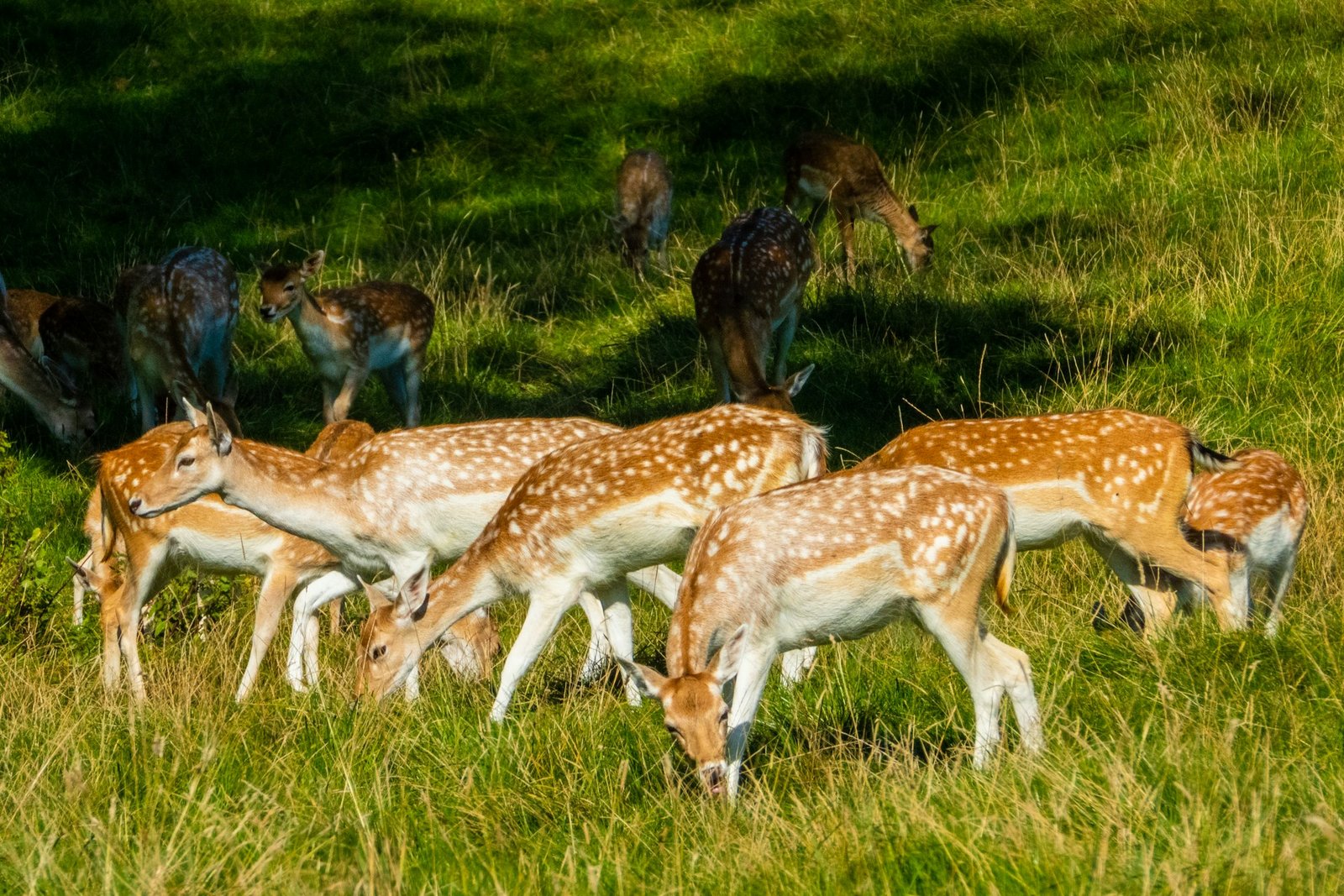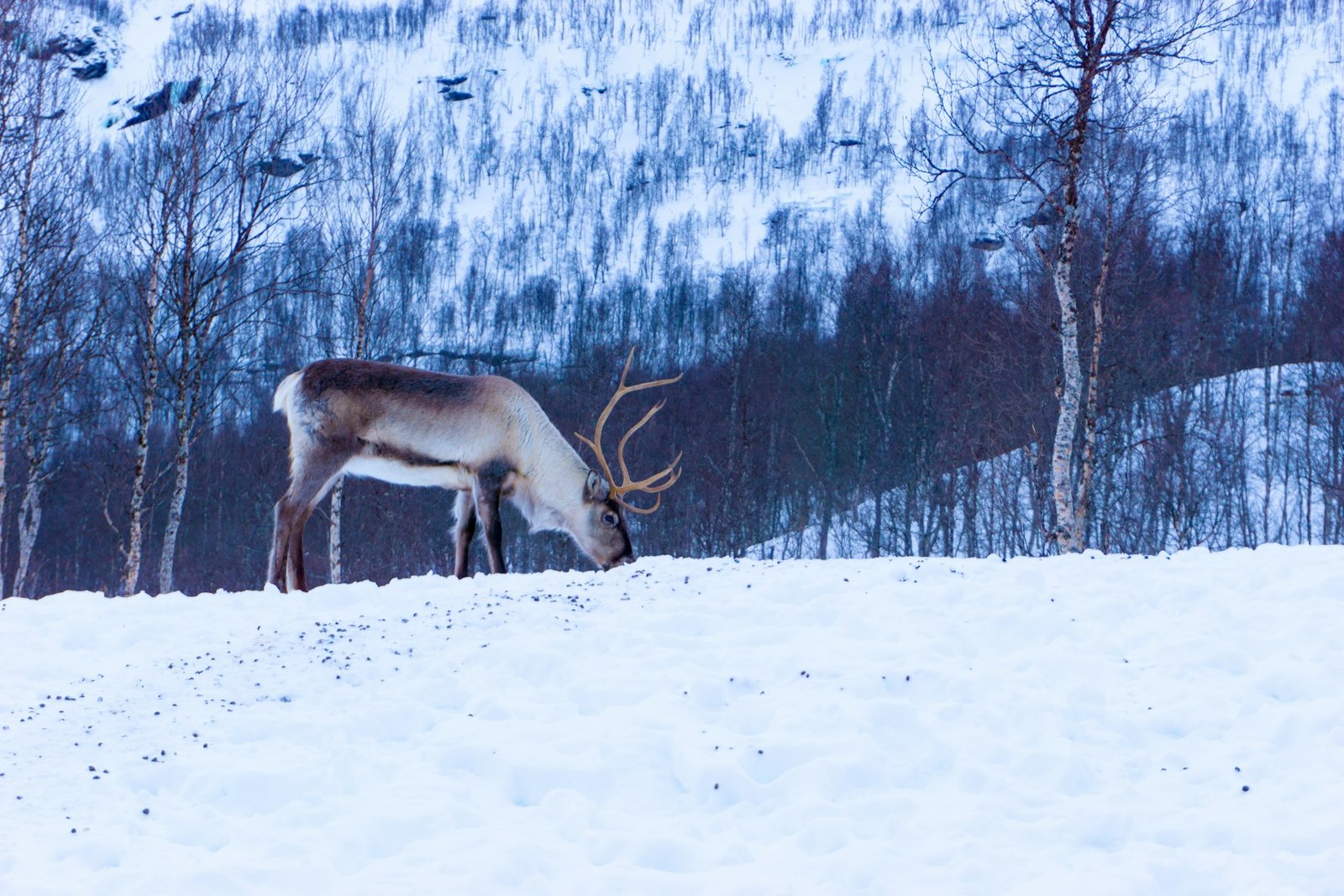Deers are known as herbivores, primarily consuming plant matter such as leaves, flowers, berries, nuts, and twigs.
They possess a specialized four-chambered stomach that efficiently processes fibrous plant material through fermentation and rumination.
Their diet changes seasonally, with a preference for nutrient-rich vegetation in spring and summer, and a shift to harder mast like acorns in fall and winter.
While there are rare instances of deer consuming non-plant matter, such as carrion or fish, these occurrences don’t alter their classification as herbivores.
Their digestive system, teeth, and feeding behaviors are all adapted for a plant-based diet. Understanding the intricacies of deer nutrition reveals fascinating adaptations for survival.
Table of Contents
Deer’s Natural Diet

Deer are nature’s ultimate vegetarians, thriving on a diverse plant-based diet that changes with the seasons. As herbivores, they primarily consume leaves, flowers, berries, nuts, and twigs, which they forage during twilight hours.
Their dietary preferences shift throughout the year, adapting to available food sources. In spring and summer, they focus on green vegetation, while fall and winter see them relying more heavily on hard mast like acorns and nuts.
You’ll find that deer are herbivores with a specialized digestive system. Their four-chambered stomach efficiently processes fibrous plant material, allowing them to extract maximum nutrients from their herbaceous diet. This adaptation enables deer to thrive on a wide range of native plant species, which is vital for maintaining healthy populations.
While deer consume various plants, they often show preferences for certain species, particularly those that are young and nutrient-rich. A diverse ecosystem with abundant native plant species provides deer with a variety of food sources throughout the year.
This diversity is essential for supporting deer populations and ensuring they’ve access to the nutrients they need to survive and thrive in their natural habitats.
Herbivore Classification Explained
To fully grasp deer’s dietary habits, you’ll need to understand the classification of herbivores and how these animals fit into this category. Herbivores are organisms that primarily consume plant matter for sustenance. Deer, including white-tailed deer, fall squarely within this classification due to their plant-based diet.
As herbivores, deer possess specialized adaptations that enable them to efficiently process plant material. Their four-chambered stomach, a characteristic of ruminants, allows for the fermentation and breakdown of fibrous vegetation. This digestive system is essential for extracting nutrients from their diet, which consists mainly of leaves, flowers, berries, nuts, and twigs.
The herbivorous nature of deer is evident in their feeding patterns and nutritional requirements. Their diet plays a critical role in various aspects of their physiology, including antler growth in males. White-tailed deer, for instance, exhibit selective feeding behaviors, often favoring high-protein, low-fiber plants that contribute to ideal growth and development.
While there have been rare observations of deer consuming meat or carrion, these instances are considered atypical and don’t negate their classification as herbivores.
Digestive System of Deer
How exactly does a deer’s digestive system allow it to thrive on a plant-based diet?
Deer, like other herbivores, possess a specialized four-chambered stomach that efficiently processes fibrous plant material. This complex digestive system enables them to extract maximum nutrients from their food through a process of fermentation and rumination.
The first chamber, called the rumen, serves as a fermentation vat where microbes break down cellulose from plant cell walls. This initial stage is essential for nutrient absorption. After fermentation, deer regurgitate and re-chew their food, a process known as rumination. This further breaks down plant matter, enhancing digestibility.
The remaining three chambers—reticulum, omasum, and abomasum—continue the digestion process, extracting vital nutrients and water from the food.
This highly efficient digestive system allows deer to:
- Survive on a diet that many other animals can’t digest
- Maximize nutrient absorption from plant-based sources
- Maintain overall health and support antler growth
The high digestibility of their diet directly influences a deer’s well-being. By efficiently processing plant material, deer can extract the necessary nutrients to thrive in various environments, showcasing the remarkable adaptation of their digestive system to their herbivorous lifestyle.
Seasonal Feeding Patterns

While a deer’s digestive system remains constant year-round, its diet changes considerably with the seasons. These seasonal feeding patterns are vital for a deer’s survival and overall health.
In spring and summer, you’ll find deer primarily consuming green leaves and herbaceous plants, which are abundant during these warmer months. As autumn approaches, their diet shifts to include hard mast like acorns and nuts. This change is essential for deer to fatten up before the harsh winter months.
When winter arrives, deer adapt their feeding habits once again. They focus on twigs, buds, and coniferous tree foliage, which remain accessible even in snowy conditions. These seasonal dietary changes directly impact a deer’s health, antler growth, and reproductive success. The quality of nutrition available during different seasons plays a significant role in these aspects of deer biology.
Deer’s adaptability as browsers allows them to take advantage of various plant materials throughout the year. This flexibility enables them to meet their nutritional needs despite the changing availability of food sources. By adjusting their diet to match seasonal offerings, deer effectively navigate the challenges posed by their environment.
Nutritional Requirements for Deer
Deer’s complex nutritional needs vary considerably throughout the year, reflecting their changing environment and physiological demands. As herbivores, they rely on a diverse diet of plant matter to meet their nutritional requirements.
In spring and summer, deer consume protein-rich green plants, while fall and winter see them turning to twigs and acorns. This seasonal shift in diet helps them maintain ideal health and supports critical processes like antler growth in males.
The nutritional needs of deer are closely tied to their unique digestive system. With a four-chambered stomach, they’re able to efficiently extract nutrients from fibrous plant material. This adaptation allows them to thrive on a diet that might be challenging for other animals to digest.
Deer’s nutritional requirements are particularly demanding during antler growth, which requires significant amounts of minerals, protein, and energy. By consuming a variety of young grasses and nutrient-rich plants, deer can support their overall health, reproduction, and the impressive annual regrowth of antlers in males.
- Imagine the strength required to grow a new set of antlers each year
- Consider the resilience needed to survive harsh winters on a limited diet
- Reflect on the delicate balance between deer and their ecosystem
Adaptations for Plant-Based Diet
To thrive on a plant-based diet, deer have evolved remarkable physical and behavioral adaptations that maximize their nutrient intake from vegetation.
Their four-chambered stomach is a key adaptation for their herbivorous diet, allowing them to ferment and digest tough plant material efficiently. This unique digestive system, coupled with specialized teeth designed for grinding fibrous plants, enables deer to extract essential nutrients from a wide variety of vegetation.
As selective feeders, deer have developed a preference for high-protein, low-fiber plants. This dietary choice supports their overall health, body size, and antler development.
Their keen sense of smell and sharp hearing play vital roles in locating nutritious food sources while remaining vigilant for potential threats. These sensory adaptations contribute to their success as herbivores in diverse environments.
Deer’s ability to adjust their diet seasonally further enhances their survival. They shift from consuming green leaves and herbs during warmer months to relying on hard mast like acorns and nuts in colder seasons.
This flexibility allows them to maintain adequate nutrition throughout the year, supporting their growth and reproductive needs despite changing environmental conditions.
Occasional Non-Plant Consumption
Most people don’t realize that deer occasionally deviate from their plant-based diet to consume non-vegetarian food sources. While typically classified as herbivores, deer have been observed engaging in surprising feeding behaviors. Research has documented instances of deer consuming carrion, including the remains of other deer and dead fish. In some cases, deer have been recorded eating up to eight dead fish per minute, demonstrating a significant rate of meat consumption when the opportunity arises.
This occasional non-plant consumption may be driven by various factors:
- Nutritional deficiencies, such as a need for salt or iron
- Scarcity of primary food sources, leading to opportunistic feeding
- Possible evolutionary remnants of early deer species’ diets
These behaviors challenge our understanding of deer as strict herbivores. While plant matter remains their primary food source, the consumption of carrion suggests a more complex dietary pattern.
This flexibility in feeding habits may be an adaptive strategy, allowing deer to supplement their nutrition when necessary. It’s essential to acknowledge that these instances of meat consumption are relatively rare and don’t negate the deer’s overall classification as herbivores.
Frequently Asked Questions
Is a Deer a Carnivore or Herbivore?
You’ll find that deer are primarily herbivores, not carnivores. They’ve adapted to digest plant material with their four-chambered stomach. While they occasionally consume small amounts of meat, their diet consists mainly of leaves, berries, and other vegetation.
Do Deer Ever Eat Meat?
Yes, deer do occasionally eat meat. You’ll find that while it’s not their primary food source, they’ve been observed consuming carrion, fish, and even small animals. This behavior often occurs during food scarcity or nutritional deficiencies.
Do Deers Eat Plants or Meat?
You’ll find that deer primarily eat plants, including leaves, berries, and twigs. However, they’ve been known to occasionally consume meat, such as carrion or dead fish, likely due to nutritional needs or environmental factors.
Can Deer Be Omnivores?
Yes, deer can be omnivores. While they’re primarily herbivores, you’ll find that they occasionally eat meat, including carrion and fish. This flexibility in their diet helps them adapt to different environments and nutritional needs when necessary.
Conclusion
In summary, you’ve learned that deer are indeed herbivores, with their diet primarily consisting of plant matter.
You’ve explored their digestive system, feeding patterns, and nutritional needs, all of which are adapted for a plant-based diet.
While deer occasionally consume non-plant items, these instances are rare and don’t negate their herbivore classification.
Understanding deer’s dietary habits is essential for wildlife management and conservation efforts.
As you consider this information, remember that ecosystems rely on the balance maintained by herbivores like deer.


